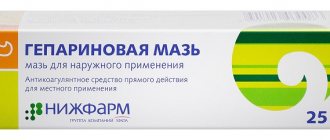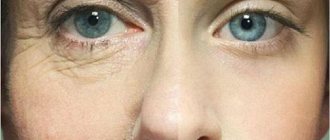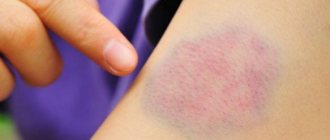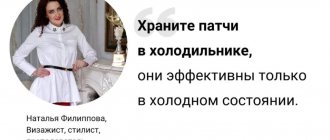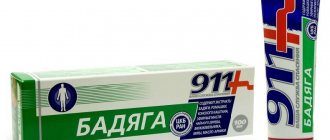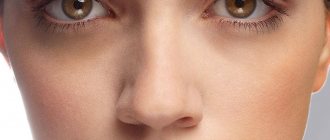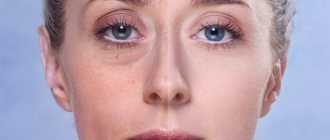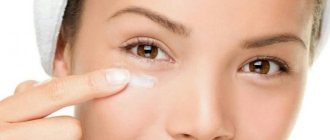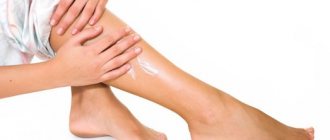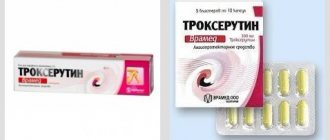The fastest-acting ointments for bruises on the face include Heparin and Heparoid. A plant-based preparation, Arnica ointment, is also effective. In case of severe swelling, Hepatrombin will help, and in the presence of compaction, Vishnevsky. In patients with a threat of suppuration, antibiotics are used: Tetracycline, Syntomycin or with iodine - Braunodin.
If the bruise occurs on damaged skin (with a wound, abrasion), then Ambulance, Rescuer, Cicaderma, Vulnuzan are recommended. Indovazin and Butadione ointment have active anti-inflammatory and decongestant effects. Traumeel and Bepanten are indicated for children from birth. Ointment dosage forms are stronger than creams and penetrate deeper into the skin. Their disadvantage is long absorption.
About bruises
A bruise is a microtrauma associated with rupture of small capillaries due to bruises/impacts, followed by hemorrhage into the subcutaneous space. It appears as a dark blue spot on the surface of the skin, which changes color from greenish-yellow to yellowish-brown as it heals. As a rule, a hematoma has a diameter of at least 1 centimeter.
Reasons for appearance
The causes of bruises are often mechanical effects on the surface of the skin. The walls of capillary vessels are quite thin and fragile, so pressing/impacting with moderate force can lead to their rupture and further release of capillary blood into the surrounding tissues. The hematoma, at the initial stage, can be either reddish or dark blue, black, or purple. In the process of healing of blood vessels and resorption of blood, the shade changes to greenish, yellowish, brownish. This color change is associated with the decomposition of hemoglobin in blood cells.
The diameter of the hematoma directly depends on the surface of the injury. In this case, the bruise may not be related to the injured area, but may appear in close proximity to the bruised part.
The appearance of a bruise may not occur until the next day after the injury. This is explained by the fact that the process of the appearance of blue color is associated with hemoglobin, which is gradually distributed in small portions throughout the surrounding tissue and colors them.
The resorption time directly depends on the size of the hematoma and the rate of blood clotting; usually the black eye disappears 7-14 days after its appearance.
What should you do before applying anti-bruise ointment under your eyes?
After a blow to the head, when there is a risk of bruising under the eyes, the first thing to do is apply cold to the eye socket area. It can be ice, snow, any clean cold object that fits the shape. You can apply napkins moistened with cold water to the site of the injury, changing them as they warm up.
Cooling the bruised tissue helps to compress the capillaries and stop the flow of blood into the subcutaneous space. The earlier the cold is applied, the less blood will have time to shed and, accordingly, the smaller the size of the hematoma. It is necessary to cool the bruise within 20 minutes after the impact; after this period, cooling the injured area will be useless. If there is damage to the skin, then first you need to treat the wound with an antiseptic, seal it with a band-aid, and only then apply dry cold.
If the injury is serious, then it is better not to self-medicate by applying ointment for bruises under the eyes from a blow, but to seek medical help. After all, a blow to the head can cause a concussion, which can have serious consequences. If there is no likelihood of serious damage, then within 20 minutes after the injury you can apply any ointment for bruises under the eyes to relieve pain, reduce the visual manifestations of the hematoma and accelerate its resorption.
Prevention of bruises - first aid for bruises
A bruise is an unwanted “decoration” on the body, especially when it is in the most visible place. I immediately want to disguise it or completely get rid of it without a trace. Let's figure out what should be done immediately after injury to avoid the appearance of a hematoma.
Fresh injury - intensity reducing agents
- Apply cold. This method will help stop subcutaneous bleeding due to vasospasm.
- Bandaging. You should not bandage too tightly; this will provide relief to the injured area and prevent swelling from increasing. It is possible to bandage only the limbs; if you bandage the face and chest, this is unlikely to help avoid the appearance of swelling.
- Applying bodyagi. This is a freshwater sponge sold in pharmacies, which is a necessary tool in the home medicine cabinet. Sold in the form of a gel and applied within 30 minutes after injury to the bruised area. Or soluble powder, which must be dissolved according to the instructions.
Stale injury (more than 1 day)
- Applying heat. This method is effective only a day after receiving a bruise. It is allowed to use heat on all parts of the body, except the face and especially the eye area; in these places the effect will be the opposite - the bruises will grow several times and the resorption process will be delayed.
- Local treatment. This includes medications sold over the counter that are intended to quickly treat injuries.
- Traditional methods. Various herbal lotions, the use of iodine, vegetables and other methods.
If pain persists or the hematoma site grows within 2-3 days, you should immediately seek help from a medical institution!
The most effective ointment for fast-acting bruises on the face: TOP 3 best
If you need a fast-acting ointment for bruises on the face, then it is better to choose drugs with heparin - Heparoid, Heparin or with herbal ingredients, for example, with arnica.
Heparoid
Geparoid ointment is used to treat bruises under the eyes caused by a blow. Its rapid action is explained by the well-absorbing base and heparin content. The drug has an anti-inflammatory effect, reduces swelling, inhibits blood clotting, which facilitates the resorption of the hematoma. 30 minutes after application, pain and skin tension decreases, and the next day the skin begins to lighten.
The ointment is applied 2-3 times a day with an interval of 4 hours, it is applied to the bruise in a layer of up to 1 mm and gently rubbed until completely absorbed. It is important to step back 1 cm from the lower edge of the eyelid and prevent the drug from getting into the eyes. The duration of treatment should not be more than 7 days. If there is no improvement during this time, then you should definitely contact a traumatologist.
Heparoid is usually well tolerated by patients, but if the skin is hypersensitive, redness, rashes or itching may occur. The drug should not be used if blood clotting is reduced or if there are diagnoses:
- hemorrhagic diathesis (tendency to bleeding);
- thrombocytopenic purpura (rash of small bruises on the body);
- thrombocytopenia and thrombocytopathy (low platelets or disturbances in their structure);
- hemophilia (congenital bleeding disorder).
Applying ointment to a black eye according to the rules (a thin layer, up to 3 times and less than 7 days) does not lead to significant absorption of heparin into the blood. Therefore, it can be used by pregnant women, but in the third trimester Heparoid should not be used for more than 3 days due to the risk of increased postpartum bleeding.
Do not use the drug on abrasions and wounds. Without a doctor's recommendation, it is not recommended to apply other ointments simultaneously with this remedy; combination with salicylic acid, tetracycline and hydrocortisone is prohibited.
With arnica
Arnica ointment is a homeopathic remedy. It helps resolve dark circles under the eyes due to the plant alkaloid faradiol; it has a local irritating effect and stimulates local blood circulation in the area of application. Arnica extract also has an anti-inflammatory effect, it activates skin restoration and stops bleeding.
Apply a thin layer 2-4 times a day with a light massage. The drug should not be used for longer than 10 days or on areas with skin diseases. Adverse reactions include rare cases of allergies - rash, skin irritation.
Heparin ointment
Heparin ointment is an affordable remedy for dark circles under the eyes (costs about 50 rubles) with a quick absorbable effect. It is explained by its complex composition:
- heparin – reduces blood clotting, swelling, reduces inflammation and congestion, activates microcirculation;
- benzyl nicotinate – facilitates the penetration of heparin by dilating small vessels;
- Benzocaine is a local anesthetic.
Heparin ointment is applied only to intact skin according to the following rules:
- thin layer;
- single dose – 0.5 cm column;
- two or three times a day;
- with a light and gentle massage;
- Avoid contact with eyes;
- After rubbing, you should immediately wash your hands;
- Cosmetic products are applied no earlier than after 40 minutes.
If swelling, redness or irritation or rashes increase, the drug is discontinued. Do not use Heparin ointment for more than 2 weeks. The drug is contraindicated in cases of reduced blood clotting.
Remedies for bruises - what are they?
Today there are a large number of variations of anti-bruise products, which differ in their speed of action and ease of application.
Gels
They have a viscous, soft consistency, which is 80% water. The active ingredients are completely dissolved in the base.
Advantages:
- Evenly distributed on the skin.
- Absorbs quite quickly.
- Residues are easily washed off with water.
- The remainder of the fatty layer is excluded.
- Releases active substances very quickly.
Flaws:
- They have a large number of side effects.
- Can be absorbed into the blood.
Crema
They are a mixture of water and oils and have a pronounced local effect.
Advantages: not absorbed into the blood and able to remain on the surface of the skin for long-term effects. They have a minimal number of contraindications and side effects.
The only drawback of creams is their more viscous and dense structure, which takes much longer to absorb than gels.
Ointments
The consistency of the ointment is quite greasy and is very poorly absorbed. Due to this, a film is formed on the surface of the skin, which promotes rapid and high-quality absorption of active components into damaged tissues. The main disadvantages of using ointments are: the remaining fatty layer and many side effects associated with good absorption into the blood. Before using the ointment, you should consult your doctor for any contraindications.
What ointments will help with dark circles under the eyes due to lack of sleep?
Bruises under the eyes caused by bruising of soft tissues bring a lot of grief, but their advantage is that they pass quite quickly, leaving no traces. Dark circles under the eyes that appear for other reasons than a stroke usually last much longer and require a lot of effort to get rid of them.
Dark circles that make a person look like a panda can appear for several reasons:
- lack of sleep, chronic fatigue;
- sudden weight loss, due to which the already thin subcutaneous fat layer in this area disappears;
- the appearance of pigmentation on the skin;
- genetically determined skin properties;
- some diseases of internal organs.
Folk remedies for quickly getting rid of bruises
There are often non-medicinal methods of dealing with bruises, many of which are quite effective. Let's look at the most useful of them:
- Using salt. This type of struggle should be used in the form of lotions. If the black eye is on a limb, then dissolve the salt in water, soak a piece of gauze or cloth in it and firmly fix it with a bandage. If it is impossible to bandage, then simply fix it with an adhesive plaster for a long time.
- Cabbage. For best results, it is necessary to use red varieties, as they contain many useful elements. To use as a lotion, rub the leaf a little with your hands and apply it to the injured area. Secure everything with a bandage.
- Potato. It is used as a lotion; for this, potatoes are finely grated, placed in gauze and applied to the area of the hematoma.
- Laundry soap. Grated soap is mixed with egg yolk and applied like a compress. Use every 30 minutes is allowed.
- Banana and pineapple. A banana peel or pineapple pulp is applied to the bruised surface. Thanks to enzymes, the bruise will quickly disappear.
Ointments based on bee venom for bruises
The effect of bee venom has not been fully studied. We only know that it stimulates the immune system. Moreover, the effect of bee venom is 30 times stronger than that of snake venom.
Bee venom in emergency ointments for bruises has a local anti-inflammatory and absorbable effect. It accelerates blood flow and enhances cellular immunity. Dilates blood vessels and causes a local increase in temperature in the application area.
Bee venom is one of the few natural ingredients with a diverse effect:
- counteract inflammation and infection by pathogens (is an antiseptic);
- warms and accelerates the blood;
- relieves muscle spasm;
- enhances cellular immunity.
The main purpose of ointments based on bee venom is the treatment of chronic joint inflammation with severe pain (arthritis, osteochondrosis, rheumatism). They are also used as an ointment for bruises and hematomas on the face, torso, and limbs . What drugs are produced based on bee venom?
Apisatron is a multicomponent composition, which contains bee venom, mustard oil, methyl salicylate (salicylic acid ester). The action of the listed components complements and enhances each other. Apisatron is intended for the treatment of muscle and joint pain. Shows anticoagulant and anti-inflammatory effects. Accelerates the resorption of small bruises and large hematomas. Used to treat adults.
Virapin is a composition with a minimum amount of auxiliary components. It contains only bee venom and Vaseline. It is positioned as an analgesic and anti-inflammatory agent, an approved ointment for bruises for children from one year old (provided there is no allergy to bee venom).
Note: 1 g of ointment is equal to the poison content of 1 bee sting.
